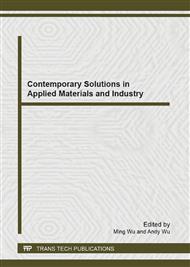p.44
p.49
p.54
p.59
p.65
p.70
p.75
p.81
p.86
Extraordinary Properties and New Functions of Nanocomposite Gels and Soft Nanocomposites with Unique Organic/Inorganic Network Structures
Abstract:
New types of polymer hydrogels and nanocomposites, i.e., nanocomposite gels (NC gels) and soft, polymer nanocomposites (M-NCs), with novel organic/inorganic network structures have been fabricated. Both NC gels and M-NCs were synthesized by in-situ free-radical polymerization in the presence of exfoliated clay platelets in aqueous systems and were obtained in various forms and sizes with a wide range of clay contents. Here, disk-like inorganic clay nanoparticles act as multi-functional crosslinkers to form new types of network systems. NC gels have extraordinary optical, mechanical, and swelling/deswelling properties, as well as a number of new characteristics relating to optical anisotropy, polymer/clay morphology, biocompatibility, stimuli-sensitive surfaces, micro-patterning, self-healing, etc. The M-NCs also exhibit dramatic improvements in optical and mechanical properties including ultra-high reversible extensibility and well-defined yielding behavior, despite their high clay contents. The M-NC also showed thermoresponsive cell adhesion/detachment. Thus, the serious disadvantages (intractability, mechanical fragility, optical turbidity, poor processing ability, low stimulus sensitivity, etc.) associated with the conventional, chemically-crosslinked polymeric materials were overcome in NC gels and M-NCs.
Info:
Periodical:
Pages:
65-69
Citation:
Online since:
April 2013
Authors:
Keywords:
Price:
Сopyright:
© 2013 Trans Tech Publications Ltd. All Rights Reserved
Share:
Citation:


